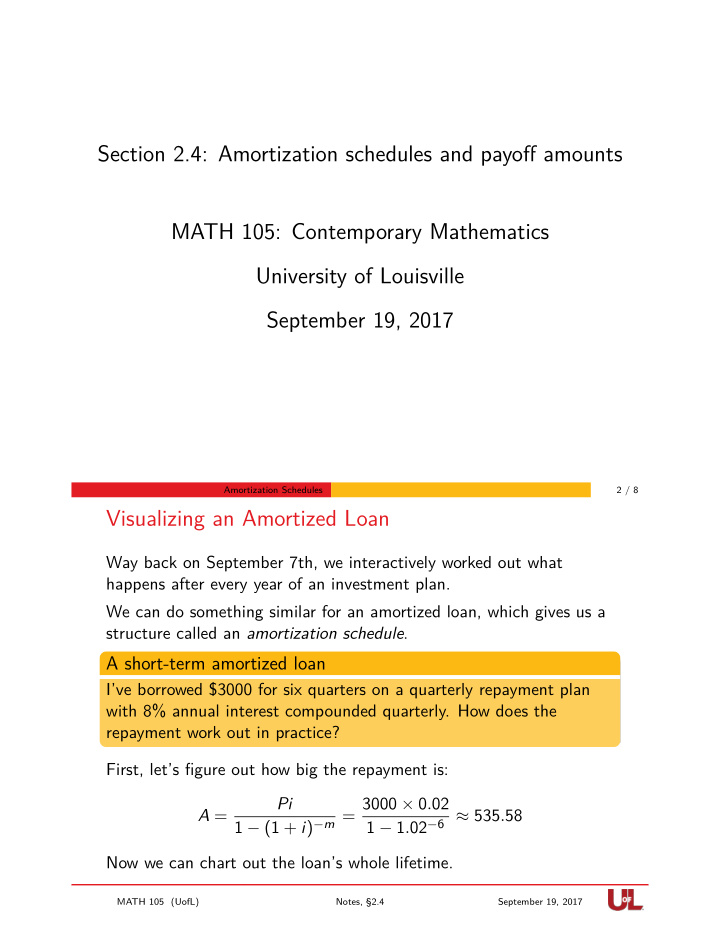



Section 2.4: Amortization schedules and payoff amounts MATH 105: Contemporary Mathematics University of Louisville September 19, 2017 Amortization Schedules 2 / 8 Visualizing an Amortized Loan Way back on September 7th, we interactively worked out what happens after every year of an investment plan. We can do something similar for an amortized loan, which gives us a structure called an amortization schedule . A short-term amortized loan I’ve borrowed $3000 for six quarters on a quarterly repayment plan with 8% annual interest compounded quarterly. How does the repayment work out in practice? First, let’s figure out how big the repayment is: 1 − ( 1 + i ) − m = 3000 × 0 . 02 Pi A = 1 − 1 . 02 − 6 ≈ 535 . 58 Now we can chart out the loan’s whole lifetime. MATH 105 (UofL) Notes, §2.4 September 19, 2017
Amortization Schedules 3 / 8 Amortization Schedules A short-term amortized loan, summarized We borrow $3000 for six quarters, with a $535.58 repayment and 2% interest each quarter. Initial Amount Interest Principal Final Quarter balance paid charged repaid balance 1 $3000.00 $ 535.58 $ 60.00 $ 475.58 $2524.42 2 $2524.42 $ 535.58 $ 50.49 $ 485.09 $2039.33 3 $2039.33 $ 535.58 $ 40.79 $ 494.79 $1544.54 4 $1544.54 $ 535.58 $ 30.89 $ 504.69 $1039.85 5 $1039.85 $ 535.58 $ 20.80 $ 514.78 $ 525.07 6 $ 525.07 $ 535.57 $ 10.50 $ 525.07 $ 0.00 Total $3213.47 $213.47 $3000.00 MATH 105 (UofL) Notes, §2.4 September 19, 2017 Amortization Schedules 4 / 8 Fundamental calculation tools for amortization ▶ The start-of-period balance each year is the end-of-year balance from the previous period. ▶ The interest charged each period is the periodic interest rate times the starting balance. ▶ The principal paydown is the total payment minus interest payment. ▶ The end-of-year balance is the start-of-year balance minus the principal paydown. ▶ The total of all the principal repayments equals the starting principal. ▶ The total amount of all payments is the total paid. ▶ The total amount of all interest charges is the total interest or finance charge . MATH 105 (UofL) Notes, §2.4 September 19, 2017
Payoff calculations 5 / 8 Per-period balances without tables Most of the entries in our table are pretty straightforward to calculate from limited information. The one thing we can’t calculate easily (without using the table!) is how the balance changes. A loan too big for tables I have a 30-year mortgage at an annual rate of 5% with an initial principal of $120,000. Payments and interest are monthly. How much balance will still be left on the loan after ten years? The answer isn’t two-thirds of the original balance, even though it seems like it should be! What we are seeking here is called the payoff amount , i.e., how much I would need to pay off the entire loan partway through its life. MATH 105 (UofL) Notes, §2.4 September 19, 2017 Payoff calculations 6 / 8 Working backwards with what we already know A loan too big for tables I have a 30-year mortgage at an annual rate of 5% with an initial principal of $120,000. Payments and interest are monthly. How much balance will still be left on the loan after ten years? Let’s start by finding out what my monthly payment would be ( P = 120000, t = 30, n = 12, r = 0 . 05): 120000 × 0 . 05 Pi 12 A = 1 − ( 1 + i ) − m = ) − 360 ≈ 644 . 19 1 + 0 . 05 ( 1 − 12 Now, what I have left, ten years into the loan, is a twenty-year loan with this payment, and we can use the formula in §2.2 for it: ) − 240 1 + 0 . 05 ( = 644 . 19 × 1 − P = A 1 − ( 1 + i ) − m 12 ≈ 97610 . 48 0 . 05 i 12 MATH 105 (UofL) Notes, §2.4 September 19, 2017
Payoff calculations 7 / 8 Generalizing the formula Same loan, but without numbers I have a loan of $ P being paid back over m periods with periodic interest rate i . How much of the balance remains after m 0 periods? Our periodic payment is Pi A = 1 − ( 1 + i ) − m And then what remains after m 0 periods is a loan with periodic payment A and a lifetime of m − m 0 periods, so our balance at this time would be P m 0 = A × 1 − ( 1 + i ) − ( m − m 0 ) = P × 1 − ( 1 + i ) m 0 − m 1 − ( 1 + i ) − m i MATH 105 (UofL) Notes, §2.4 September 19, 2017 Payoff calculations 8 / 8 Seeing that in context Let’s look at the result of that formula on our original 5 % mortgage, over its whole lifetime: ) m 0 − 360 1 + 0 . 05 ( P m 0 = 120000 × 1 − 12 ) − 360 1 + 0 . 05 ( 1 − 12 $120,000 $100,000 Balance P m 0 $80,000 $60,000 $40,000 $20,000 30 60 90 120 150 180 210 240 270 300 330 360 Number of months m 0 MATH 105 (UofL) Notes, §2.4 September 19, 2017
Recommend
More recommend